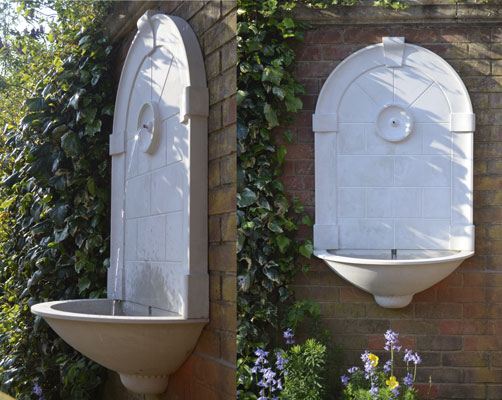wall fountain
by jim mccloskey
No matter whether it's for business or pleasure, I'm always open to the history of a place when I travel: It helps me put what I'm seeing in context and enriches my understanding of how things have come to be - and why they endure. In trips to Europe, for example, you often come across small, nondescript public fountains, usually in the oldest parts of cities from London to Paris to Rome. In several cases, my curiosity about them has led me to do a bit of research.
As it turns out, most of these modest fountains were set up originally to supply the general populace with fresh, safe water for drinking, cooking, bathing and many other uses besides. And some of them date back 2,000 years and more to the Roman era, when water systems and aqueducts were built throughout the empire and hydraulic engineers used head pressure and gravity to keep Rome's far-flung outposts going.
Some are little more than spouts dribbling out of wall sconces or from plain, blocky structures in public squares - and on several levels I find myself preferring them to the gaudier expressions of watershaping that garner far more attention, including Rome's Trevi Fountain, the Fountains of Versailles outside Paris and countless other water displays that are more about decoration (or ostentation) than they are about functionality.
Among my favorite examples on the purely functional end of the spectrum is the one seen in the accompanying photographs: It is Il Facchino ("The Porter"), a tiny wall fountain I saw on the Via Corso in Rome many years ago. Sculpted around 1580 (apparently by the artist Jacopo del Conte, although some have claimed it is actually the work of Michelangelo, which would really be something special), it was set up as an outlet for a restored Roman aqueduct that had been inoperable for centuries before various Popes started investing in Rome's infrastructure. (The fountain was moved a short distance to its current location on a palace wall in 1874.)
In the period before the aqueducts were returned to service, it had been the job of porters such as this nose-free fellow to fetch and deliver water from the Tiber River to Rome's citizenry, making the sculpture's purpose a neatly ironic statement on what was becoming an outmoded job description. But what is really cool about this fountain - beyond its imperial roots, Michelangelo possibilities and the wicked irony - is the fact that this is one of five of Rome's so-called pasquinades, or "talking statues."
It seems that witty citizens of Renaissance Rome once poked fun at the city's administrators or commented satirically on affairs of the day by posting placards or pamphlets on or around these five fountains and, for whatever reason, only these five fountains. Copies of the lampoons would be made and the information disseminated widely - a sort of 16th-century version of The Onion combined with Facebook.
This is why I so enjoy doing my homework on watershapes such as Il Facchino: It's cool enough that this fountain was a key public utility in what was then (as now) one of the world's most populous cities, but to think of it being a billboard for blasphemies great and small makes it even more appealing.
Perhaps this history explains why the poor porter is so unfortunately absent his nose?
Haddonstone (USA) Ltd (Bellmawr, NJ) now offers a wall fountain as part of its Athenian…














